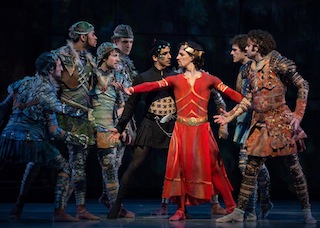
"Camelot" a Triumph for Cincinnati Ballet
King
Arthur and Camelot have been celebrated in epics, poetry, film, the Broadway
musical, even political imagery.

“King Arthur’s Camelot” came to Cincinnati Ballet Feb. 13-16 at the Aronoff Center for the Performing Arts, a world premiere and centerpiece of the company’s 50th anniversary season.
The $1.6 million production has everything going for it: gifted dancers, colorful choreography by artistic director Victoria Morgan, spectacular visuals, a newly commissioned score by Canadian composer John Estacio -- performed live by the Cincinnati Symphony Orchestra led by Carmon DeLeone -- an epic tale known to all, and at the heart of it, a dream of what might be in the best of all possible worlds.
That Cincinnati Ballet succeeded, and with flying colors, is a testament to how far the company has come in its first half-century.
This reviewer saw the Feb. 15 matinee, with the cast headed by Joseph Gatti as Arthur, Adiarys Almeida as Guinevere and Romel Frometa as Lancelot.
Estacio’s color-drenched score opened in fanfare style on a set commanded by a rising (or is it setting?) sun. Young Arthur (Anthony Green), prompted by Merlin (Liang Fu), draws the sword from the stone (Excalibur), setting the plot in motion. Arthur (Gatti) soon meets Guinevere (Almeida), occasioning an athletic, sometimes comical, pas de deux, which morphed into a waltz as the two chased a butterfly.
A tambourine-laced, folk-like dance set the scene at court for Arthur and Guinevere’s wedding, which featured a soft, tender dance for the two, capped by a sweeping, dramatic finish, including some daunting leaps and catches.
The entrance of Lancelot (Frometa) occasioned some minor sparring among the knights (bearing swords), but things grew ominous with the arrival of Mordred (Rodrigo Almarales) a black-caped figure spawned by the three Ladies of the Lake, who drift across the stage atop billowing, blue fabric.
Guinevere arranges a joust between Lancelot and Gawain, carried out on horseback via two giant puppet horses -an impressive feat accomplished by four company members with Frometa and Grubbs atop them brandishing lances. Gawain is killed, but Merlin, with great effort, brings him back to life. Lancelot and Guinevere discover their love for each other in a moment of silvery music, and it remained only for Mordred to cast doubts in Arthur’s mind, as Estacio’s cinematic score turned dark and foreboding.
Things reached their dénouement in act II with Mordred seeking an opportunity to betray Guinevere and Lancelot to Arthur. The lovers dance a pained pas de deux in the forest, but are discovered, and Mordred, whose mocking choreography heightened the menace of his character, exited laughing.
With Guinevere condemned to be burned at the stake, there was a conflagration onstage. Though Arthur relents and frees her, everyone meets his maker, with only Arthur left alive (barely). Things come full circle as a boy wanders among the carnage and tries to make off with Excalibur. Instead, Arthur flings it dramatically to the skies and dies in a pool of light, to soft strains by the orchestra.
It made for a moving end to a highly affecting show and a triumph for Cincinnati Ballet.